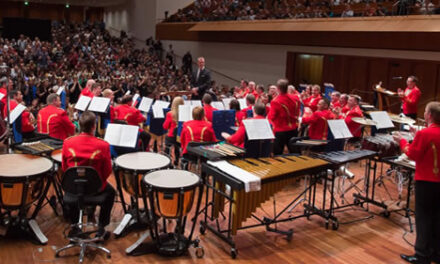For those people not familiar with this exceptional group, the name “The Academy of Ancient Music” (AAM) might well conjure up images of cave drawings of primitive instruments and knuckle-scraping beings banging on animal skins with dinosaur bones. Despite the somewhat pedantic name and its long distinguished history, this is a group very much alive, vibrant and capable of playing music with a flair and freshness that breathes life into some very familiar works. Established in 1726, the AAM’s purpose was, even then, the studying and performing of “old” music – initially defined as music at least 100 years old, but eventually including such “modern” composers as Handel.
With Christopher Hogwood as its director (not present on this tour), the AAM has come to symbolize what is now known as the Historically Informed Practice (commonly known as “HIP”) style and approach to early music. Previously known by such names as “period” or “authentic” instruments performance practice, HIP has became somewhat of an all-encompassing designation that turns up as a description of anything from a Medieval song to a Brahms symphony.
There was a long line in the front of Duke Chapel on Sunday, October 19, a beautiful fall afternoon. A flight delay prevented the group from arriving until about 30 minutes before show time, so the fight for good seats was intensified when the doors finally opened. Unless you saw the advertisements with the photo of this touring group, you’d probably be surprised that this wasn’t a chamber orchestra-size ensemble. In fact, there were only eight players: two violins, viola, cello, bass, flute, and theorbo, all directed by Richard Egarr, from the harpsichord. The group was set up on a platform at the front of the Chapel with a very unsuccessful attempt to place microphones in various spots to “help” the sound for those unfortunate souls more than ten rows back.
Except for two pieces by Heinrich Biber at the start of the second half, this was an all J.S. Bach affair containing three very popular works and, by any account, three of his greatest. The HIPness began with Suite No. 2 in B minor, S.1067, for flute, strings and continuo. I use the HIP term right away because those who may not have been exposed to this style of playing were immediately struck by the difference. There is a lightness, a transparency, a feeling that a veil has been lifted – somewhat like grunge being cleaned from a Renaissance painting. A description of the instruments, bows, and what constitutes “informed practice” from this period is beyond this modest scribbling, but there is ample information on HIP techniques (along with some very heated debates) on the Internet or even in (gasp!) books. In this first work the main difference was the use of the Baroque transverse wooden flute. Much less piercing than its modern metal counterpart or even a recorder, this instrument blends with the strings in its woodiness rather than standing apart. At first you might have missed the punch and power of steel, but the subtlety and personality of the Baroque flute as played by Rachel Brown soon overwhelmed you. The ensemble was like one breathing organism as the brilliance of the small group made you wonder about the need for larger groups with multiple players per part.
Richard Egarr, director and harpsichord soloist, was next featured in the Concerto in D minor, S.1052. This is one of the earliest examples of the harpsichord being freed from its continuo role and allowed to shine as a solo instrument within an ensemble setting. The theme, played in unison by strings and harpsichord, is noble and profound, and it is spun out in typical Bach brilliance. Egarr was a delight to watch as his enthusiasm and love for playing this splendid music spilled out to the audience. With the harpsichord in the solo spotlight we were finally able to hear William Carter take over continuo duties on theorbo, basically a lute with additional unfretted bass strings added – increasing the length of the instrument to nearly seven feet!
The two sonatas by Heinrich Biber that started the second half are intriguing and revelatory works, rich in harmonic and rhythmic variety. Somehow it is nice to find that there is still music that is relatively little known that is powerful and unique and just waiting to be tasted.
The evening closed with something you’d be likely to find on one of those recordings such as “Greatest Hits of 1729”: Bach’s Brandenburg Concerto No. 5 in D, S.1050, for flute, violin and harpsichord. It is famous for what may be the first harpsichord cadenza, but the keyboard often overshadowed the powerfully moving second movement, with its dialogues involving the flute and the violin. Violinist Pavlo Beznosiuk displayed great phrasing and tone, and the trio possessed fluidity, grace, and a communal rubato that was understated but nonetheless brilliant.
A resounding standing ovation brought the group back for an astounding display by Rachel Brown on a flautino, which is to the standard recorder what the piccolo is to a flute. The final movement of Vivaldi’s Flautino concerto whizzed by as this wonderfully HIP afternoon regrettably came to an end.











